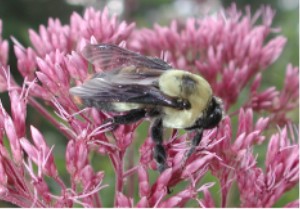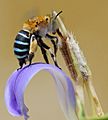Coevolution facts for kids
Coevolution is when two or more different species affect each other's evolution. This means that changes in one species can lead to changes in another. It's like a dance where partners change their moves based on what the other is doing. Over long periods, species that live closely together often evolve together.
Here are some examples of coevolution:
- Friends helping friends:
- Rivals and enemies:
Coevolution is very common in nature. Sometimes, many species are involved, not just two. For example, in mimicry rings, many species might copy each other's warning signs. When one species develops a new or "improved" feature, the other species it interacts with often develops a related feature in response.
Contents
How We Learned About Coevolution
The idea of coevolution started with Charles Darwin. In his famous book, The Origin of Species, he talked about how cats could affect the amount of heather flowers. Here's how: Cats hunt mice, and mice raid bumblebee nests. Bumblebees are important because they pollinate red heather. So, more cats mean fewer mice, which means more bumblebees, and finally, more heather!
Later, a scientist named Hermann Müller did important work on coevolution. He studied bees and how flowers evolved. Darwin even mentioned Müller's work in his book The Descent of Man. Müller wrote about how flowers and insects adapted to each other, showing he really understood coevolution.
Flowers and Their Pollinators
The lives of living things are deeply connected, not just with their surroundings, but with other species too. These connections can last for millions of years. A great example is the relationship between flowering plants and insects, which leads to pollination.
Scientists have found clues in fossils of ancient beetles and flies. Their gut contents, wing shapes, and mouthparts suggest that these insects were some of the very first pollinators. This shows how long this special relationship has been going on!
Parasites and Their Hosts
Another clear example of coevolution is malaria. This involves three partners: a mosquito, a tiny parasite called Plasmodium, and a land animal like a mammal or bird. The type of malaria parasite is different depending on the animal it infects. This means there are thousands of these unique relationships, all following the same pattern.
Many species of parasites have evolved very quickly. For instance, in a group of tiny insects called Erythroneura, about 150 times they switched hosts. This led to about 500 new species in that group!
Parasites are incredibly common. Studies of insects in Britain showed that about 35% are parasites on plants, and a bit more are parasites on animals. This means nearly 71% of insects in Britain are parasites! Since British insects are well-studied, it suggests that most insect species worldwide are parasites.
Many other groups of invertebrates (animals without backbones) are also mostly or entirely parasitic. For example, flatworms and roundworms can be found in almost every wild vertebrate (animals with backbones). Tiny protozoan parasites are also everywhere. This shows that being a parasite is probably the most common way of feeding on Earth!
How Many Species Are There?
Coevolution helps explain why there are so many millions of different species on Earth. Many species are parasites, or they are specially adapted to live on just one or a few hosts.
For example, a single type of tropical tree can be home to about 162 different kinds of beetles that live only on that tree. Since there are 50,000 types of tropical trees, and beetles make up a large part of all insect species, scientists believe there could be as many as 30 million types of arthropods (insects, spiders, etc.) living in tropical forests. This is a huge number compared to the 1.4 to 1.8 million species that scientists have already discovered! It seems we have greatly underestimated how many species exist.
A big reason for this huge number of species is phytophagy. This is when insects eat plants. There are so many insect species, and each often eats only one or a few plant species. And it's not just insects; fungi, nematodes (roundworms), mites, and other invertebrates also specialize in this way.
Coevolution Across Different Places
A species is often made up of many separate groups, called populations. These populations might live in slightly different habitats. They will also interact with other species that vary from one habitat to another. This means that certain traits (features) that help a species survive might be more useful in one population than another.
This idea is part of the geographic mosaic theory of coevolution, developed by John N. Thomson. This theory suggests:
- Different populations of a species will have different traits because of their unique interactions.
- The traits of interacting species will only perfectly match in some places.
- Few coevolved traits will spread to all populations and become fixed in a species. This is because these traits are not helpful everywhere.
Coevolutionary relationships are always changing. They shift as the climate and habitats change, or when new species move into an area, or others disappear. These changes affect which traits help a species survive, and that's how adaptations change. What biologists see today is just a snapshot of a natural world that is always evolving. Even so, many well-known coevolution relationships have lasted for millions of years, even as the species themselves have slowly changed. This idea, where species change but stay in the same coevolutionary relationship, led to the Red Queen hypothesis.
Related pages
- Evolutionary arms race
- Rough-skinned newt, garter snake and toxin resistance
- Defence against herbivory
- Figs
- The Red Queen
Images for kids
-
A Purple-throated carib hummingbird feeding from and pollinating a flower.
-
A brood parasite: a Eurasian reed warbler raising a baby common cuckoo.
See also
 In Spanish: Coevolución para niños
In Spanish: Coevolución para niños







